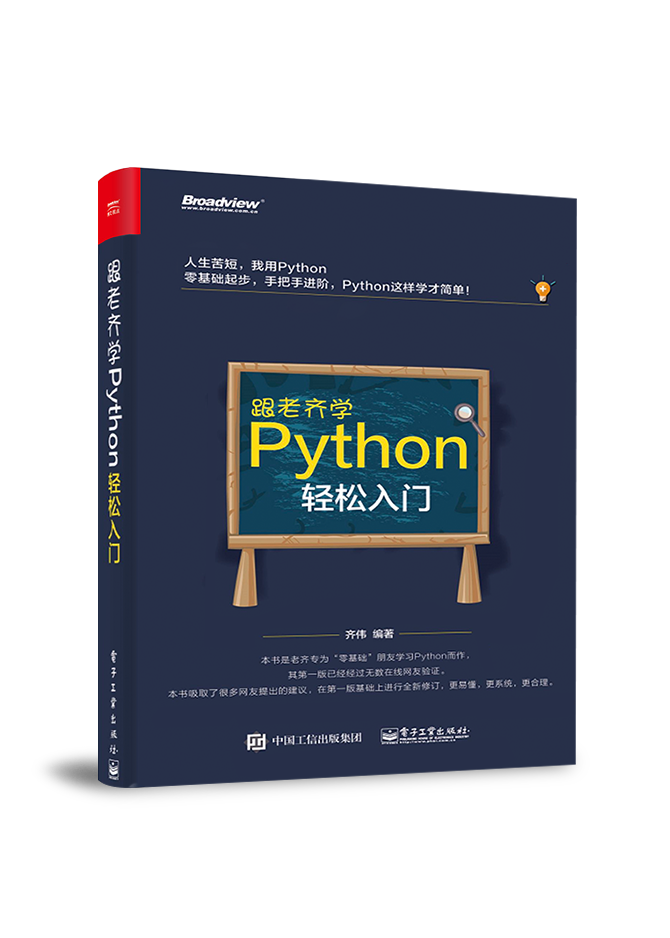Python3.9中合并字典的新方法
2020-04-13
作者:Yong Cui, Ph.D.
翻译:老齐
与本文相关的图书推荐:《跟老齐学Python:轻松入门》

Python3.9,还在研发中,计划今年10月份发布,2月26日,研发团队发布了α版,其中有一个新功能,会关系到所有开发者,那就是两个操作符:|和|=,分别实现对字典的合并操作。
本文对此给予简要介绍。
字典
Python中的字典,即dict,是一种重要的内置对象类型,它是一种以键值对方式保存数据的容器,因为使用了哈希,使得查询字典中数据时的时间复杂度恒定,这是它美名远播的一个原因。
例如:
1 | # 创建字典 |
以往合并字典的方法
有时,我们需要将两个字典合并,在Python3.9之前,有几种方法可以实现。假设有两个字典:d1和d2,新建一个字典d3,它的值是d1和d2的并集。从下面的演示中我们可以看到,如果字典中被合并的字典中有重复的键,例如d2如果是字典d2a那样,就会把d1中同名的键覆盖了。
1 | # two dicts to start with |
update()方法
第一种方法我们使用字典的update()方法,下面的代码中演示了操作方法。注意,首先要创建d1的拷贝,否则update()会把原字典的值修改了。
1 | # create a copy of d1, as update() modifies the dict in-place |
如果字典中有重名的键,我们必须更加谨慎,确定保留哪些值。如下代码所示,作为update()方法的参数d2a中,与d3有重复的键,比如a,此时会遵循“最后一个有效”的原则合并。
1 | d3 = d1.copy() |
解包字典
第二种方法使用字典解包,类似上面的方法,如果有重名的键,依然是“最后一个有效”。
1 | # unpacking |
使用dict(iterable, **kwarg)
利用dict(iterable, **kwarg)方法创建一个字典。如果参数iterable是一个字典,就可以创建一个同样键值对的字典,再提供另外一个字典,就可以将这个字典的键值对增加到前面字典中。注意,这个字典如果跟前面字典中有同名的参数,依然是“最后一个有效”。
1 | d3 = dict(d1, **d2) |
注意,上面的方法只适用于以字符串为键的字典,因为它其实是以关键词传参。如果像下面这样,就会报错了。
1 | >>> dict({'a': 1}, **{2: 3}) |
合并字典的新方法
在最近发布的Python3.9.0α4中,提供了合并运算符|,用于很方便地实现两个字典的合并,下面给出一个示例。你一定会注意到,如果两个字典中有重名的键,依然是“最后一个有效”,这与前面所看到的没有区别,比如update()方法那样的操作。
1 | # use the merging operator | |
与上述运算符相关的是一个增强版的运算符|=,它的作用是对字典进行原地修改,从本质上讲,与update()一样,以下代码段显示其用法:
1 | # Create a copy for d1 |
总结
本文展示了Python3.9即将发布的一个关于合并字典的运算符,此外,对asyncio、math、os模块也有一些更新,迫不及待了吗?10月份Python3.9发布之时,官方文档会有详细说明,敬请查看。
原文链接:https://medium.com/better-programming/dictionary-merging-and-updating-in-python-3-9-4ac67c667ce
搜索技术问答的公众号:老齐教室
在公众号中回复:老齐,可查看所有文章、书籍、课程。
觉得好看,就点赞转发
若你觉得我的文章对你有帮助,欢迎点击上方按钮对我打赏

关注微信公众号,读文章、听课程,提升技能
